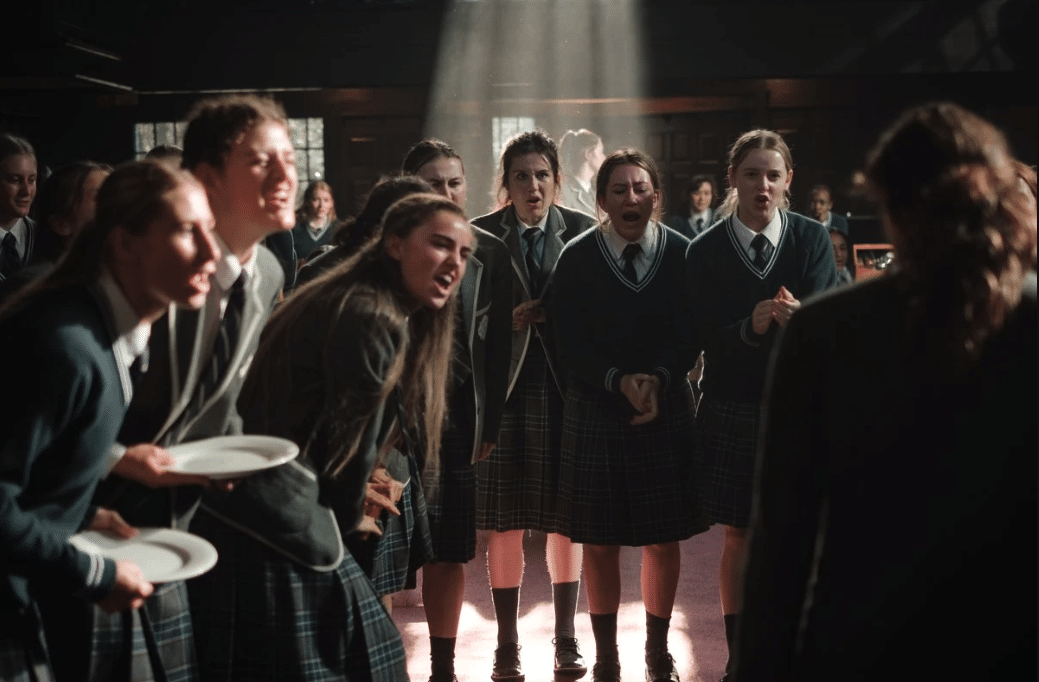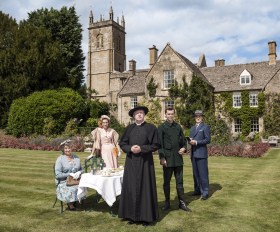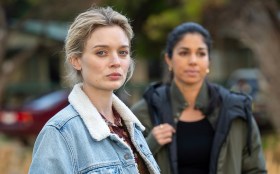Stan’s four-part adaptation of Rebecca Starford’s wilderness-campus memoir Bad Behaviour begins with a warning that it contains subject matter some viewers may find distressing. Having been primed by Yellowjackets – which, unlike ScreenHub’s squeamish editor, I adored – I was ready for this.
But I was looking for distress in the wrong places. While the series does depict and discuss some upsetting acts of violence and self-harm, it is more disturbingly matter-of-fact in depicting unkindness at every intensity, from malice and manipulation to cowardice, complicity and selfishness.
Director Corrie Chen (New Gold Mountain) and writers Pip Karmel (Total Control) and Magda Wozniak (Surviving Summer) rarely indulge in the melodramatic horror the show’s premise invites. Instead, they skewer the more banal miseries people inflict on each other, and the destructive behavioural patterns that get baked in when we’re teenagers.
I wasn’t expecting how much I’d recognise my own teenage memories here, and reflect on my own past unkindnesses. Bad Behaviour is very astute about how keenly you feel every tiny slight, how much you crave approval, how easily you can be led, and how casually cruel you can be. How your loyalties can point in the wrong directions.
It sticks with you
The series weaves between two timelines. In flashbacks we follow the grim year that 15-year-old scholarship student Jo McKenzie (Jana McKinnon) spends at Silver Creek, the remote wilderness campus of an elite private school. Ten years on, Jo is jolted from her comfortable yet aimless life as an aspiring writer when at her casual job as a concert-hall usher, she encounters her former Silver Creek classmate Alice Kang (Yerin Ha), now an internationally successful cellist.
The show doesn’t quite go down the Rashomon path, but it’s striking how little insight the 25-year-old Jo has into how differently Alice might remember Silver Creek. She’s genuinely hurt that Alice rebuffs her friendly overtures.
McKinnon (The Trouble with Being Born) expertly conveys how Silver Creek has shaped Jo’s values without her really having noticed. Initially she’s a wholesome nerd who bonds shyly with Alice. But she ages into a dissatisfied, self-sabotaging adult who’s all but estranged from her mum Caroline (Diana Glenn), and who’s careless with the feelings of her besotted second housemate, Saskia (Daya Czepanski).
Because Silver Creek had a femme fatale. Bold, wealthy Portia (Markella Kavenagh) clearly has never had to fear consequences in her life, and she delights in the power and attention of toying with her classmates’ feelings and goading them into destructive stunts.
Episode one actually begins with a shot of a moth drawn to a light. So, too, Jo abandons Alice to join Portia’s gruesome hangers-on, who include thuggish Briohny (Melissa Kahraman), not-too-bright Ronnie (Erana James), and eager Sarah (Bronte Locke). Inevitably, adult Jo finds herself serving canapés to Portia, Ronnie and Briohny at Alice’s concert. She reconnects with Portia and helplessly falls back into their old abusive dynamic.
The costume, hair and makeup team on Bad Behaviour must be congratulated for how convincingly the cast appear as both teens and twentysomethings. This is particularly effective in one pivotal present-day conversation where Jo and Portia appear in Jo’s current house as their teenage selves – a clever way to show that we can’t escape the people we used to be.
A moral wilderness
The series uses Jo’s warm but no-nonsense housemate Ruby (Mantshologane Maile) as a one-woman Greek chorus, pointing out all the delusions that grip Jo:
‘Why can’t you just talk to Saskia? Be kind. Be honest,’ Ruby says.
‘Like it’s that easy,’ scoffs Jo.
A repeated motif here is what’s easy versus what’s hard. Campuses like Silver Creek are often touted as resilience-boosters: as Portia repeatedly insists, ‘It was bloody hard, which was the point’. Jo tries to defend her past actions to Alice: ‘Silver Creek was hard for me too!’
But with her usual moral clarity, Ruby scorns Silver Creek as an indulgence specific to rich people: a struggle LARP of running, hiking and camping, and a disastrous evacuation of adult supervision. As adults, Jo and Portia muse that their earnest young housemistress Miss Lacey (Tuuli Narkle) wasn’t much older than them – and we see how her youth undermined her authority.
Ruby grasps, as Jo can’t, that our society enables its Portias to continue behaving badly, coated in Teflon privilege. But the show offers only glimpses of Portia’s inner world, her complex and unsettled sexuality. This is the solipsistic Jo’s story, so Portia is a slippery cipher: a catalyst for Jo to make bad decisions. Even ten years later, Jo is ready to burn her life again: to lose her job like it’s a scholarship; to alienate her chosen friend family like her blood family.
‘Why are you letting this be such a big deal?’ 25-year-old Jo says to Alice. But Alice is the one who did hard work at Silver Creek, and even harder work to move on from it. She’s free, while Jo and the others are trapped.
So, too, in a different way, is Emma (Abbey Morgan), the only Silver Creek student who pushed back on its cruel conditioning, and who became Alice’s best friend. In one flashback, Emma jokes with Jo and Alice as they pretend cold canned stew is delicious gourmet food – a poignant glimpse of the genuine friendship Jo could have found there. Alice describes Emma as ‘courageous and good,’ ready ‘to do what was right, and never what was easy.”
These Manichean motifs of good versus evil recur throughout the series. ‘You were the worst,’ Alice tells a shocked 25-year-old Jo. And Jo’s self-talk – which her combative dynamic with her mother reinscribes – is that she was ‘a good girl’ when she arrived, but now she’s ‘bad’. (The mother–daughter dynamic here feels underwritten, however. At times I wondered if Caroline is meant to have been a more unpleasant figure than Glenn’s compassionate performance conveys.)
At Silver Creek, Jo senses that something bad is ‘out there’; but her heart is the true moral wilderness. To emphasise this point, Chen shoots the landscape to recall the inner turmoil of the Romantic sublime. The canopy is frequently viewed from below, waving monumentally in the breeze. Chen frames Jo like a Caspar David Friedrich painting: on a mountaintop from behind, gazing out across the vista. And as Jo and Alice walk through the bush on their first day, a tree looms over them, creaking; something feels about to fall.
For me, the weakness of the series is its denouement, when the adult Jo returns to Silver Creek to face the ghosts of her past. The series is otherwise so good at sitting with moral ambiguity that this felt too literal and simplistic.
But Bad Behaviour has a powerful message: that ‘bad’ and ‘good’ are not intrinsic. Behaving cruelly is easier than striving to be kind, but the series ends on the hopeful possibility that Jo won’t behave badly forever.
All episodes of Bad Behaviour are streaming now on Stan.
Actors:
Director:
Format: Movie
Country:
Release:





